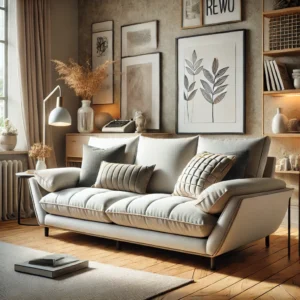Your cart is currently empty!

The Science Behind Sofa Comfort: What Makes a Sofa Truly Comfortable
 When shopping for a sofa, most people prioritize comfort above all else. But have you ever stopped to think about what actually makes a sofa comfortable? Comfort isn’t just about sinking into something soft—it’s the result of a combination of design elements, materials, and ergonomic considerations. Let’s delve into the science behind sofa comfort and uncover what makes a sofa truly cozy and supportive.
When shopping for a sofa, most people prioritize comfort above all else. But have you ever stopped to think about what actually makes a sofa comfortable? Comfort isn’t just about sinking into something soft—it’s the result of a combination of design elements, materials, and ergonomic considerations. Let’s delve into the science behind sofa comfort and uncover what makes a sofa truly cozy and supportive.
1. Ergonomics: The Key to Proper Support
Comfort begins with ergonomics—the study of designing products that fit the human body. A well-designed sofa should provide proper support for your spine, neck, and legs. Here’s how ergonomics influences comfort:
- Seat Depth: Ideal seat depth typically ranges from 20 to 24 inches, allowing most people to sit comfortably with their feet flat on the floor and their back supported.
- Seat Height: A standard seat height of 15 to 18 inches ensures that the knees are at a 90-degree angle when seated.
- Backrest Angle: Sofas with a backrest angle of about 100-110 degrees offer a relaxed but supportive position.
- Armrest Height: Armrests should align with the natural resting position of your arms to avoid strain on your shoulders.
A sofa that’s too deep or too high can lead to discomfort and even long-term posture issues.
2. Cushioning: The Perfect Balance of Softness and Support
Cushions are perhaps the most noticeable feature of a sofa when it comes to comfort. The type of cushioning material used plays a significant role:
- Feather Foam: A combination of feathers and foam provides a luxurious, sink-in feel while maintaining durability.
- High-Density Foam: Offers firm support and retains its shape over time, making it ideal for people who prefer a more structured seating experience.
- Memory Foam: Contours to the body, providing personalized comfort and reducing pressure points.
- Layered Cushioning: Many sofas feature multiple layers of materials (e.g., a foam core with a feather top) to combine the best properties of softness and support.
The density of the foam is crucial; densities between 1.8 and 2.5 pounds per cubic foot are considered ideal for long-lasting comfort.
3. Upholstery Fabrics: The Role of Texture and Breathability
The fabric covering the sofa also contributes to its overall comfort:
- Natural Fabrics: Cotton and linen are soft, breathable, and ideal for warmer climates.
- Synthetic Fabrics: Polyester and microfiber are durable and stain-resistant, making them a practical choice for families.
- Leather: Known for its durability and luxurious feel, leather adapts to body temperature over time, enhancing comfort.
- Blends: Fabrics that combine natural and synthetic fibers offer the best of both worlds: softness and durability.
Texture matters too. Smooth fabrics like velvet offer a plush feel, while textured fabrics like boucle provide a cozy, tactile experience.
4. Frame Quality: The Foundation of Comfort
A sofa’s frame provides the structure that supports the cushions and upholstery. High-quality materials and construction techniques ensure that the sofa remains comfortable over years of use:
- Wooden Frames: Hardwood frames (e.g., oak, maple) are strong and durable, making them ideal for long-lasting support.
- Metal Frames: Lightweight and sturdy, metal frames are a good choice for modern designs.
- Joint Construction: Look for frames with reinforced joints (e.g., dowels, corner blocks) to prevent wobbling or sagging over time.
A poorly constructed frame can lead to uneven support, no matter how good the cushions are.
5. Suspension Systems: The Hidden Comfort Factor
Beneath the cushions lies the suspension system, which plays a critical role in how a sofa feels:
- Sinuous Springs: Also known as S-springs, these offer firm, even support and are common in modern sofas.
- Eight-Way Hand-Tied Springs: Found in high-end sofas, this system provides superior comfort by evenly distributing weight across the seat.
- Webbing: Elastic webbing is a budget-friendly option that offers decent support but may wear out faster than springs.
The suspension system works in tandem with the cushions to create the ideal balance of comfort and durability.
6. Customization: Comfort Tailored to You
No two people are alike, which is why customization options can significantly enhance sofa comfort:
- Modular Sofas: Allow you to adjust the layout to fit your body and living space.
- Adjustable Features: Reclining backs, extendable footrests, and adjustable headrests cater to specific comfort needs.
- Personalized Cushions: Some manufacturers offer customizable cushion firmness levels to suit individual preferences.
Investing in a sofa tailored to your needs ensures long-term satisfaction.
7. Aesthetic Comfort: The Psychology of Design
Comfort isn’t just physical—it’s psychological too. A sofa’s design can influence how relaxed and at ease you feel:
- Color: Softer, neutral tones like beige and gray create a calming atmosphere.
- Shape: Curved, inviting shapes are perceived as more comfortable than rigid, angular designs.
- Lighting: Positioning the sofa in a well-lit, cozy space enhances the overall experience.
When a sofa aligns with your personal style and complements your living space, it becomes a haven of relaxation.
Conclusion
The science of sofa comfort involves much more than meets the eye. From ergonomics and cushioning to upholstery and frame quality, every element contributes to how a sofa feels. By understanding these factors, you can make an informed choice and invest in a sofa that offers both physical and psychological comfort for years to come.
Whether you’re looking for a cozy spot to curl up with a book or a supportive seat for entertaining guests, remember that true comfort lies in the details. Choose wisely, and your sofa will become the heart of your home
Leave a Reply